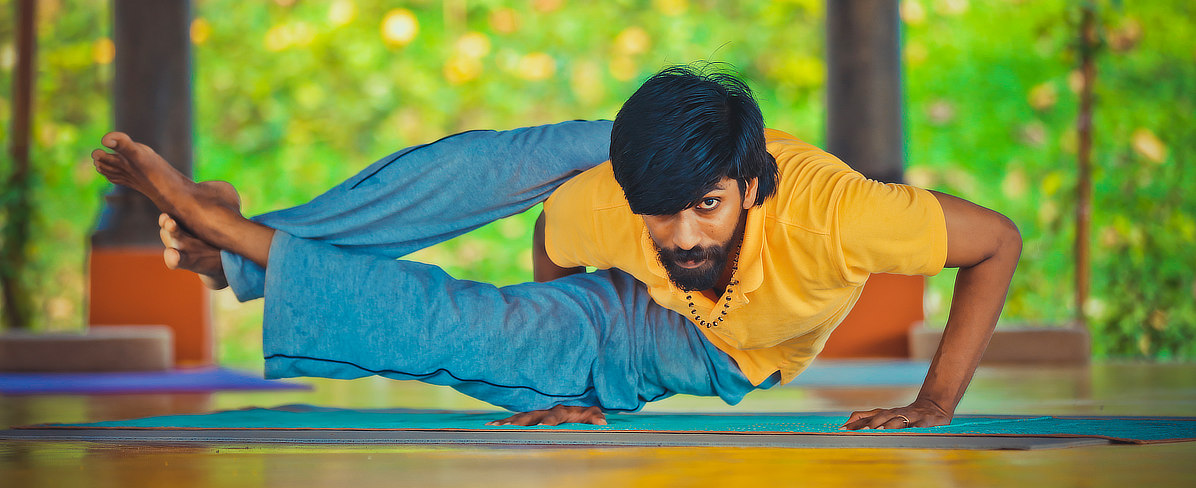Yoga
Yoga is a science, a philosophy and an art that touches a person’s life on a physical, mental, emotional and intellectual level.
Although Yoga only became a philosophy and school through the Yoga Sutras of Patañjali, the practice of Yoga has existed since the beginning of mankind.
The word «exercise» here does not only stand for body positions (āsana), for which yoga in the West has mainly become known. For the name «Yoga» comes from the root yuj, which means «to unite». Yoga means union, the union of the small individual self with the higher self. The own mind, the thinking, the patterns in which our thinking (and thus also our actions) take place, are the biggest obstacle that has to be overcome. If you can control your mind, your thoughts and your senses, you can go beyond them, you can transcend them.
In order to achieve this, one must exercise various things, i.e. practice them regularly so that they become a habit.
Yoga according to Patañjali
Yoga according to Pañjali offers eight methods for this, often referred to as an eightfold path
yama – refers to ethical rules or the code of conduct in dealing with others
(basically, these are restrictions to which one submits –> ahiṃsā – do not hurt, satya – truthfulness, i.e., not lying, asteya – not stealing, brahmacarya – self-control in the sense of abstinence, aparigraha – not accepting gifts, incorruptibility, not being greedy)
niyama – describes the personal discipline, the ethics in dealing with oneself
(these include śauca – inner and outer purity, santoṣa – cultivation of contentment, undemanding nature, tapas – discipline and renunciation, svādhyāya – exploration of the self, introspection, īśvara praṇidhāna – complete devotion to the highest)
āsana – means «position» and in the case of Patañjali it refers to the correct position for meditation. In Hatha Yoga this term is used to describe the different body positions.
prāṇāyāma – means mastery or control of the life energy and includes the various breathing exercises (prāṇa means «life energy» and āyāma stands for «expansion», «enlargement» but also «control»)
pratyāhāra – refers to the control of the senses. The Sanskrit term pratyāhāra means «withdrawal» and in the context of yoga means the withdrawal of the senses from their sensory objects.
dhāraṇā – means «concentration» and refers to the fixing of the mind to a point, a place. Dharana belongs to meditation, but also describes the ability to keep the mind focused on one thing, one action in everyday life.
dhyāna – means «meditation». In the sense of Patañjali, the mind in dhyana is so concentrated that it is absorbed. The attention flows without thoughts.
samādhi – denotes the state of transcendence, the experience of the self or the highest.
Yoga is therefore not only a way to practice physical, breathing and meditation exercises to maintain health. Rather, Yoga is a philosophy and a method to continuously develop one’s personality in order to achieve the highest goal, the union with the Supreme.
Patañjali’s eight-limbed system has great therapeutic value and was incorporated into Ayurveda for this purpose.
In the Ashtanga Hridayam, a textbook of Ayurveda, the following verse is found, which takes up the methods of Patañjali
nityam hitāhara vihārasevi samīkṣyakari viṣayeśvasaktaḥ ||
dātā samah satyaparah kṣamāvān āptopasevi ca bhavatyarogaḥ ||
A person who eats healthy food, always practices a healthy lifestyle, carries out all his actions consciously and is not involved in the objects of the mind [i.e., excessive enjoyment of sensual pleasures], who is generous, just, truthful, forgiving in nature and helpful to others, will remain aroga – free from disease.
It is not only the concrete measures such as correct nutrition, correct daily and seasonal routines and physical activity that have an influence on a person’s state of health. Also his state of mind, his way of seeing and living life – in dealing with himself, but also with others and with nature – have a direct influence on the body and its functions, because all processes of the consciousness have physical, mental and emotional correspondences.
Yoga in the Vedasudha Ayurvedic Hospitals
Within yoga there is a variety of āsana (body positions), mudrā (special body and hand positions), bandha (contraction exercises to direct the flow of energy) and prāṇāyāma (breathing exercises).
We have put together a special program of exercises for our patients. These are easy exercises in the sense that the practitioner does not exert himself too much physically or mentally during the Panchakarma treatment. This would be detrimental to the success of the treatment.
Nevertheless the selected exercises are very effective. They have an effect on the internal organs like liver, spleen, pancreas, stomach and intestines and are supposed to regulate their functions and especially Agni, the digestive fire. A well functioning Agni is the key to good health and important for the success of ayurvedic treatments.
Our daily yoga program includes one hour of Yoga Asanas, about 30 minutes of Yoga Nidra and about 20-30 minutes of Pranayama. The participation is optional.
Once a year a special three-week yoga retreat is offered at the Yogasudha Ayurvedic Hospital (Pinnakkanadu). The retreat includes practical yoga sessions, theoretical classes, cleansing techniques, gentle ayurvedic treatments, meditation, mantra chanting, yogic-sattvic food and much more.


